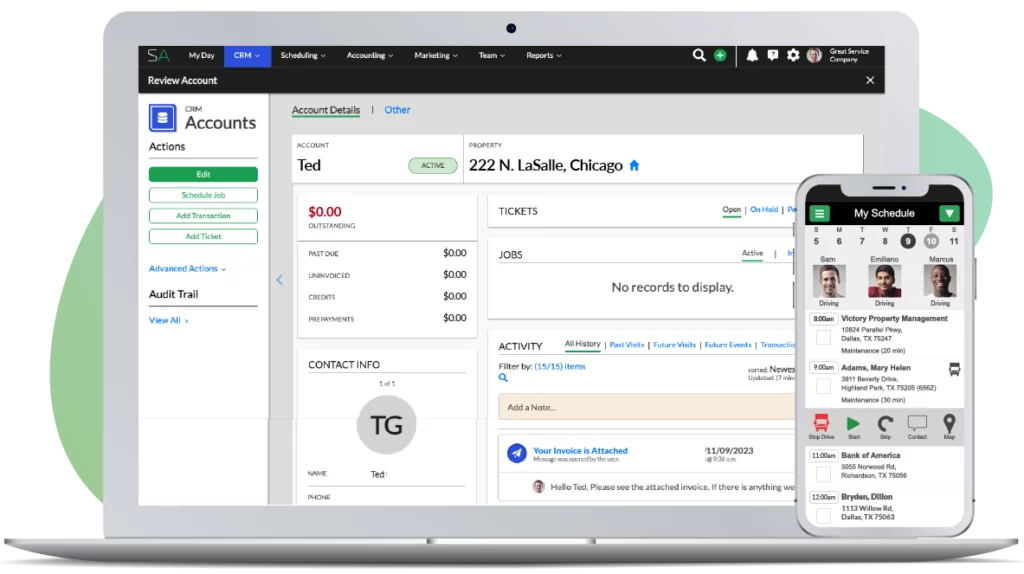Jonathan and Erich discuss how to buy lawn care equipment with confidence.
Jonathan: Is he in the camera? Maybe step in just a hair.
Erich: How’s my hair?
Jonathan: Your hair’s perfect.
Speaker 3: That’d be great.
Erich: Yeah?
Jonathan: I don’t even think we need to talk. I think people will watch this video just for your hair.
Erich: I look good.
Jonathan: All right. You ready?
Erich: I’m ready.
Jonathan: All right. It’s awesome to see you. Thanks for being here.
Erich: Thanks for the invitation.
Jonathan: No, of course. Appreciate you guys coming on a weekend. Basically what I want to do, we’ve got some really sharp guys in the office today and kind of on a whim we decided, “Let’s record some videos that might give you some great ideas.” You guys have great ideas. You’re running a big operation. You’re the founder of the company. You’ve been doing this for a really long time. The thing that I’m not really an expert at, but I feel that you have a lot of wisdom on, is equipment. You guys live in a world of very expensive equipment.
Erich: Yes.
Jonathan: Very expensive equipment. How in the world do I figure out, when I’m buying equipment, what I should be buying? Should I be buying Stihl? Should I be buying the competitor? Do I pick a brand? Do I stick with just a brand? Enlighten me a little bit. Enlighten all of us on, as somebody who has a lot of wisdom around this, how do we buy equipment? What should we be thinking about?
Erich: Well, the first thing Jon that we need to understand is that it’s not a tool. Equipment’s not tools. It’s toys.
Jonathan: Okay.
Erich: Right? It’s always toys.
Jonathan: Okay.
Erich: Bigger motors are better. Faster machines are better. It’s all about the toys. Right? Which looks cooler in your hands? It’s not how you do the job. It’s how good you look while you’re doing the job. Right?
Jonathan: Okay.
Erich: Kind of like golf.
Jonathan: That’s really the only buying criteria right?
Erich: Well, no. Okay. We got to talk about Stihl versus Husqvarna. Two great brands on the marketplace today. They each have a niche market. They have the top sellers hands down. Top, best 2 chainsaws on the market. You got Homelite. You got RedMax. You got some other companies out there. They’re doing sort of, but if you want a machine that’s going to run every day, that’s going to keep your guys out there in the field, then you’re going to look at 1 of 2 brands as far as chainsaws go. That’s either Stihl or Husqvarna.
Jonathan: Now, are you soliciting the input of your team?
Erich: Absolutely.
Jonathan: Or are you just making the decision saying, “This is what we’re using for maintenance, and long term costs.” How do you figure that out?
Erich: See, for me I started, my dad, when I was a little kid, he had a small engine shop. He sold Husqvarna chainsaws.
Jonathan: Okay. I didn’t actually know this about you.
Erich: In 1982. Back a million years ago, 1982, we built a saw, rebuilt it and made it run better, and it set a world record in a lumberjack competition. It was a Husqvarna chainsaw. I have a love for Husqvarna chainsaws. I’ve had guys that come to my company, to come work with me, that have a love for Stihl chainsaws. They think that the Stihl is absolutely the best unit on the marketplace. Right? We had to decide which one are we going to run? Well, actually we didn’t so we kind of run both.
Jonathan: Oh, you do?
Erich: Yeah.
Jonathan: Okay, so you don’t find any challenges from running both, like from a parts standpoint, or a training standpoint?
Erich: We’re in a good marketplace. We’re near Charlotte, North Carolina, and Charlotte has really good service for both Stihl and Husqvarna. We did have some challenges with climbing saws. The laws changed so the Husqvarna 200T, which was a phenomenal saw, they couldn’t sell them anymore.
Jonathan: Emissions stuff?
Erich: Emissions issues.
Jonathan: Okay.
Erich: They had to reinvent that saw. Then Husqvarna came out with a new climbing saw and their first attempt with the new climbing saw wasn’t what it should have been. We had some challenges with that.
Jonathan: We saw that in the 21 inch mower market between Honda and Kawasaki years back as well. Okay, so you will run both brands, but the challenge is, you guys are a big operation, and a very smart operation. If I was just getting started and I’m doing maybe 100 grand a year, would you still run? Let’s say I’ve got 3 guys. A couple climbers and 1 guy wants Stihl and 1 guy wants Husqvarna. Do I give them each a different saw or would you in that case, and I’m not trying to lead you. I don’t know the answer. Would you have 2 different saws when you’re really small or does that work better as you get bigger?
Erich: You know, as you get big, I think when you start it doesn’t matter as much but as you grow you need to look at how many chains do I need to buy? How many bars do I need to buy because bar length, if I’ve got to have 5 different lengths of bar, then that’s a whole lot of inventory I’ve got to carry. Different lengths of chain, different kinds of chain. Say 3/8 versus 3/8 low pro versus 63 gauge for Stihl and 50 gauge for Husqvarna. I mean, there’s all these specifics. We pared it down to a climbing saw, a medium sized ground saw, and a large saw for big cuts. That way we can stock just parts for those saws, just chains for those 3 styles of saw, and just bars for those saws.
Jonathan: Okay, but is that a more advanced strategy? What I mean by more advanced strategy as the company matures, is that something most people can afford to do or is that as, first you start out with 1 saw, and I’m showing my ignorance here, you start out with 1 saw and you start out with different blade sizes and you flip them out. Then, as you have more money you say, “Okay, I’m going to get these dedicated saws.” Is that what you’re saying?
Erich: Well I would say that, starting out a company find something you really like and push in that direction. You may have a climber come in that he only wants to use a particular saw, and you may have to educate him to the brand you’re going to be using. But, if you don’t quickly take a hold of the style of saw, the particular brand you’re going to run, then you’re going to end up with a huge pile. If you’re just a 1 man operation, you got a few guys, you’re going to probably be going to your local supplier to get the saw, and the chain, and the bar that you need. You’re probably not going to have a huge stock in your shop. We didn’t have a huge stock until we got mechanics in place and that was almost 10 years in.
Jonathan: Okay, maybe before I let you run here, 3 quick buying tips. If I’m buying equipment, trucks, technology, supplies of some kind, anything that I’m buying in my company that we’re going to spend a lot of money on, what are maybe the 3 top criteria you’re looking at to decide if I should buy this brand, if I should buy from this vendor? I know you guys have figured that out so what are you thinking about?
Erich: Yeah, top criteria. Well, you’ve got to find good service number one. You got to find somebody that will take care of you when you’re down because being down is a lot more expensive than whatever it costs to fix that piece of equipment. Chainsaws and whatever, it’s broken, go get another one and get back to work. That’s how it’s going to make money for you. As far as trucks, I would look at, do I buy new or used? We’ve got trucks on the market that will do a million miles if they’re cared for. International trucks is what we prefer to use so we went with a larger truck. We started with a 1 ton truck, found out that’s not big enough. You’re going to out grow it quickly. You look at what are the big guys doing? Say, “I’m going to reproduce that.” Find out what’s working for them, say, “Why is it working for them?” Go forward with that.
Jonathan: Have you picked a philosophy, new or used?
Erich: Yes. We’ve picked the philosophy of used.
Jonathan: Used, okay. That’s what we’ve done as well.
Erich: We look at hiring good mechanics that can get our stuff fixed because even new stuff breaks. You got to take it to the shop and it’s going to sit there for 3 weeks for warranty work. Well, I’d rather have it in my shop, pay for the warranty myself, get it fixed, and get it back to work. Unless it’s a blown motor or something that’s a really big deal, but then you’re going to go to the manufacturer and argue that out.
Jonathan: Okay. What else are you going to think about?
Erich: As far as equipment, chippers, big deal. Chippers. Do you do Vermeer, Morbark, Brush Bandit, you know? Bottom line for us is we picked a brand that really worked well for us that we could get good service. I’ve got a shop and we do our own warranty work, which is huge. We end up with Morbark chippers because that was the brand that we found we got the best support from. Now there’s a lot of good machines out there.
Jonathan: I got to stop you for a second. You said something I haven’t heard before. You said you do your own warranty work?
Erich: Mm-hmm (affirmative).
Jonathan: Are you licensed with the brand to do your own work or how does that work?
Erich: Well, it’s a training. We go through it.
Jonathan: You go through training with the brand and they …?
Erich: They give us permission to do our own warranty work. That simply means they give us the parts. We get approved that it’s a warranty issue. They give us the parts, but still it’s our cost and labor.
Jonathan: Okay, okay. Interesting. Even that’s a new concept for me. I hadn’t, actually. My team probably knows.
Erich: Really?
Jonathan: Thank goodness they run the company. I actually hadn’t heard of that before so that’s kind of cool. I learned something.
Erich: Well, overshadowing all of this, when we talk about equipment, we talk about making your companies more valuable, more productive. But, Jonathan, what you have given us as far as the software, the Service Autopilot program has revolutionized how we do business.
Jonathan: That’s awesome.
Erich: It helps us track our equipment, helps us track every piece of equipment that’s in the field and when it needs to be serviced. It helps us track every single employee. Yeah, we’re a bigger company and we’re growing strong, but without that system in place we wouldn’t be where we are.
Jonathan: Well, I appreciate you guys using it. You guys have been awesome. Awesome to work with. We’ve learned a lot from you. So thank you and thanks for all the ideas.
Erich: Good stuff. Thank you. All right buddy.
Jonathan: Appreciate it.



